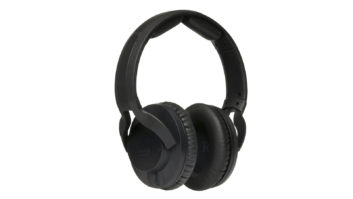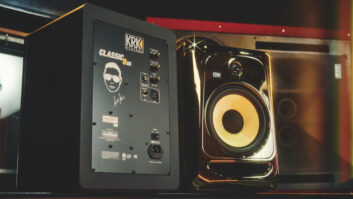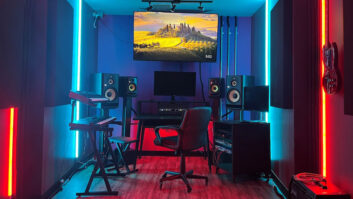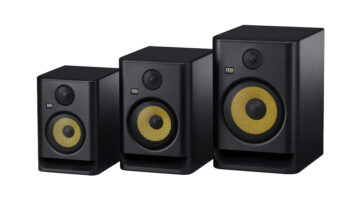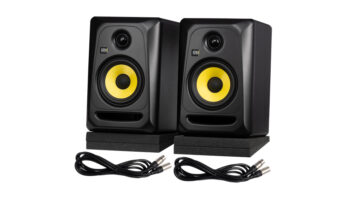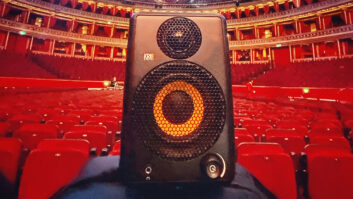Having owned a pair of KRK V8s for several years, I wanted to evaluate the V88s (the company’s newest self-powered monitors) and see how they would compare to the smaller — and popular — V8s.
ENTER THE V88
Priced at $1,199 each, the V88 is a bi-amplified system, intended for near- or mid-field monitoring. The stated frequency response is 39 to 23k Hz, +2 dB. Each enclosure has two 8-inch woven Kevlar drivers wired in parallel and powered by a 160-watt amp. The two woofers have an approximate combined surface area of an 11-inch driver. However, 8-inch speakers do not move air like 12-inch units do, even if the total surface area is almost the same. The 1.25-inch polymer dome tweeter is fitted with an excellent elliptical waveguide and driven by a 60-watt amp.
Each V88 weighs 50 pounds, is sturdily constructed, and is coated with a black/gray “Zolatone” finish, giving the units a pro look and feel. The V88s are 13.6×20×17 inches (H×W×D) and are well-shielded — even an inch from my video monitor, the picture display was unaffected.
The V88s accept a wide variety of inputs: The Neutrik Combo XLR/TRS input connector on the rear panel is active and balanced, and handles an unbalanced signal as well. The crossover uses three-way active filters and a 2.3kHz crossover point. The slopes are -12 dB/octave, Butterworth types, with an additional -12dB/octave subsonic filter that’s -3 dB down at 21 Hz.
Response can be tweaked via LF and HF contour controls. A three-position switch adjusts the HF shelving at 1 kHz to flat, ±1 dB. A three-position LF toggle has a -3dB corner frequency cut at 39, 47 or 55 Hz. An overall system gain/trim input sensitivity pot has a -30 dB to +6 dB range. The internal power supply can be set for 100 to 120 or 220 to 240 VAC operation, and the power switch is delayed and muted to avoid power-up/down thumps.
LISTENING TESTS
The first thing I expected from the V88s was increased LF response. The bass was full and deep, yet the mids and highs made the biggest initial impression. Listening to familiar material, songs seemed to “open up,” and — as clichéd as this may sound — I found myself saying things like, “Oh, there is an organ part in this tune!”
The V88s are loud! But determining exactly how loud is a mystery. The manual rates the maximum 1m SPL at 112dB “music” and 115dB “peak.”
That being said, these things are louder than you could possibly ever want, or need! I couldn’t turn them up enough to overload the drivers or amps without risking deafness.
I like the fact that, unlike some powered monitors, the V88s do not have an input limiter. You might blow the drivers or your ears, or burn up the fuses, but not trigger a limiter. Because there is an input gain trim, you should be able to hear the speakers overload and correct the problem before you have the input mush out. This is the correct way to design a powered monitor.
DOWN UNDER
As I mentioned before, the bass response is big, fat and full. But I was spoiled, having the optional $1,499 S12 subwoofer in the chain. While the V88s bottom is accurate and usable, it is nowhere near what you get with the sub added.
I also had to adjust my listening position, pulling back a few feet, to allow the longer bass wavelengths to develop for the fullest bottom response. Sitting as close as I had with the near-field V8s provided too much mids/highs and a lot less bottom. By their very nature, the V88s are mid-field monitors. If you use them as near-fields, then change your listening position by moving your chair back a little. Conveniently, this also widens and improves the “sweet spot” a bit. However, the V88’s sweet spot is very wide and on-axis at almost any distance and reasonable position.
Combined with the S12 subwoofer, the V88 could become the standard monitoring system for small- to mid-sized studios. These would easily serve as mains in post rooms, larger studios or for 5.1 surround mixes. Anyone who’s worked in a large, world-class studio knows the sound and feel of soffited mains cranked up loud. That’s what you can expect from the V88s, only they’re right in front of you, not 15 to 20 feet away. I’m sure I’ll catch flak for this from purists, but the S12/V88 combo reminds me of the sound of a pair of Augspurger mains.
Of course, the V88s are just fine by themselves, but I’d suggest saving your pennies to add the S12 to the package. The S12/V88s give smaller-studio owners and their clients a chance to hear what mixes will sound like in a club. And almost as loud! When your legs feel the air produced by the kick, or when a bass or bass synth uses a frequency below the lowest note on a bass guitar, or a sub-harmonic generator is used in the mix and your room resonates with so much bottom you wonder if the building will collapse, you know you’ve got it. For anyone doing hip hop or R&B sessions, this is what you’ve been looking for.
KRK Systems/Stanton Magnetics, 3000 SW 42nd Street, Hollywood, FL 33312; 954/689-8833; fax 877/478-2686; www.krksys.com.
Bob Buontempo is a freelance producer/engineer based in the New York City area.
THE KRK S12 SUBWOOFER
So far, I’ve raved about how the S12 sounded with the V88s, but I should mention that I first tried the sub with my V8s, having received the S12 weeks before the V88s arrived. As with the V88s, the S12/V8 combination offered excellent overall sound quality, with improved imaging accuracy, extended frequency response and increased SPLs.
Now let’s look at some S12 specs, features and a few design flaws.
The S12 has a 12-inch, woven Kevlar speaker, powered by an internal 160-watt amp. Frequency response is stated as 31 to 50 Hz (sweepable), topping out at 130 Hz (±2 dB). The I/Os are balanced XLRs. Amplifier gain is adjustable (+6 to -30 dB). The rear panel also has a phase reverse switch and a variable lowpass filter (50 to 130 Hz). A highpass filter on the outputs to the full-range speakers is fixed at 80 Hz. The enclosure is 15×22×20 inches and weighs 72 pounds. Once again, the SPL ratings are non-standard: Max SPL @ 1 m is 112dB music and 115dB peak. Its Zolatone finish matches the other V Series speakers.
The S12 does not have a manual [The manual is now available, according to KRK — Editors], but does anyone need instructions for a speaker? Normally, I’d agree, except not having information not only makes the setup difficult, but could also detract from the system’s sound, if configured incorrectly. And, logistically, it’s a pain to set up alone: You’ll need an assistant.
All S12 controls are on the back panel — good economic sense, but impractical. In a small studio like mine, where the S12 is placed on the floor, near a wall or under the desk, accessing its rear AC switch is nearly impossible. So I could either always leave it on or turn it off via a power strip, which would defeat the purpose of the “non-thump” power switch.
Setting up, my first instinct was to “Y” the output from the mixer and feed one signal into the V88s and the other into the S12. However, a call to KRK informed me that the S12 had a built-in 80Hz crossover. The mixer’s control room outs route to the S12, and the V88’s 80Hz highpass signal comes from the S12, becoming a three-way, tri-amplified system. How could anyone know that without a manual?
Crawling behind the S12, I found the sweepable lowpass filter, but with no markings on the pot, where was 80 Hz? After another call to KRK, the answer was “somewhere around 1 or 2 o’clock.” KRK should silkscreen the frequencies around the knob or detent the pot at 80 Hz. Finding the correct sub output level is a lengthy matter of trial and error. Adjust the pot behind the speaker, move the speaker back into place and listen to the level change. Not quite right? Do it again. It’s not easy to remember a 1 or 2dB volume adjustment for three or four minutes, but after an hour of futzing, I had it set okay.
Setting the two-position phase switch is simpler — it’s much easier to hear something that is not subtle. The S12 does not have a switch for bypassing the sub and routing full-bandwidth audio to the mains for making A/B comparisons between the sub-in/out sound. Finally, I kept kicking the woofer cone because it’s under the console. KRK doesn’t make a grille or cover, although they were working on one about eight months ago when they started writing the S12 manual…
Besides these “inconveniences,” the S12 sounds great. Combined with the V88s, I doubt that you can find a system this good for the price. Just have an assistant help you set the thing up!
— Bob Buontempo

